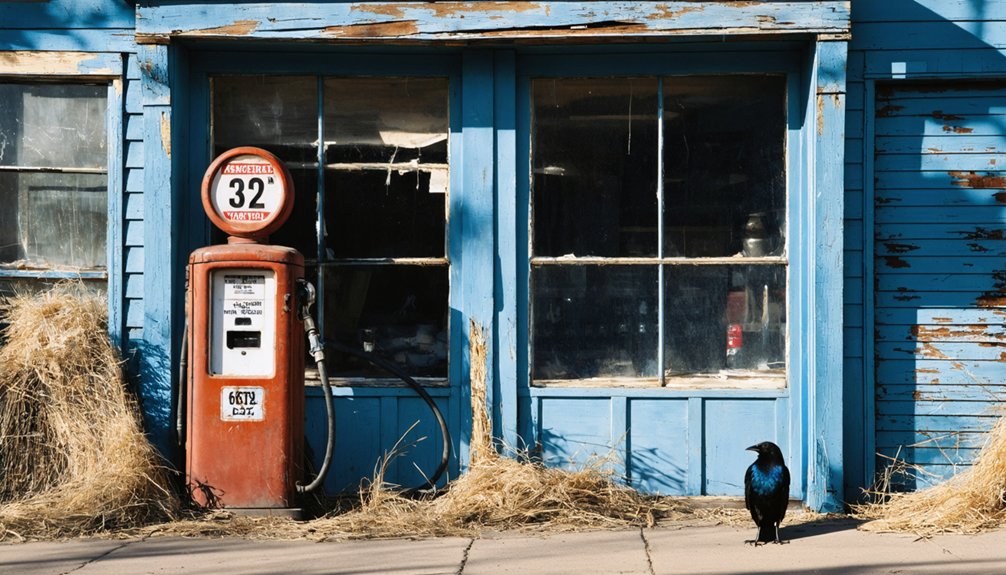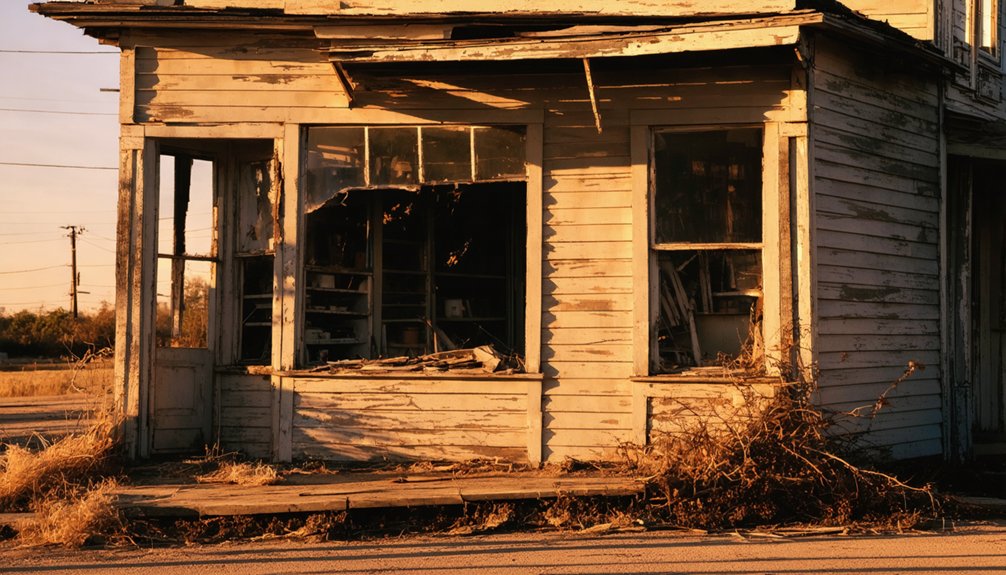You’ll find Dillon among Texas’s lost frontier settlements, established in 1900 by E.F. (Frank) Dillon in Hopkins County. He built a general store and cotton gin, creating an agricultural hub with a post office by 1903. Despite early promise, the town’s isolation from railways and loss of postal service in 1906 led to its decline. By the 1930s, Dillon had vanished completely, leaving only traces of its brief but notable existence.
Key Takeaways
- Dillon was established around 1900 in Hopkins County, Texas, by E.F. Dillon, featuring a general store and cotton gin.
- The town’s decline began with the closure of its post office in 1906, marking the start of its transformation into a ghost town.
- Poor transportation infrastructure and isolation from railways contributed significantly to Dillon’s economic downfall and eventual abandonment.
- The community completely disappeared by the 1930s after failing to transition from horse-drawn to automotive commerce.
- Today, only a grassy mound marking the former kiln site remains, with the area now converted to private farmland and pasture.
The Birth of a Frontier Settlement
As the nineteenth century drew to a close, E. F. (Frank) Dillon set his sights on establishing a new frontier settlement in Hopkins County, Texas. Around 1900, he began transforming the rural landscape into what he hoped would become a thriving agricultural community, about 30 miles east of Miller Grove. Like many names that would require disambiguation pages, the town of Dillon shared its name with several other locations across America.
Despite the settlement struggles of frontier life, Dillon’s vision quickly took shape. He opened a general store that would become the town’s cornerstone and partnered with O. P. Wardrup to build a cotton gin, essential for local farmers.
A blacksmith shop emerged to service the community’s equipment and transportation needs, while a kiln was constructed for firing bricks. By 1903, you’d find a proper post office operating within Dillon’s store, connecting the fledgling town to the wider world. Mail carriers made regular trips from the Saltillo depot using horse-drawn buggies to deliver correspondence to the townspeople.
Frank Dillon’s Vision and Early Enterprise
Frank Dillon’s entrepreneurial spirit drove three key initiatives that shaped his frontier settlement. In the 1890s, he established agricultural foundations by constructing essential infrastructure including a blacksmith shop, general store, and brick kiln.
He then expanded operations through a strategic partnership with O.P. Wardrup to process cotton locally. Drawing from the era’s prominent immigrant entrepreneurs, his determination mirrored the successful business practices of other newcomers to America. He and his wife Madeline G. Dillon would later accumulate eight mineral interests in the region.
Your understanding of Dillon’s vision deepens when you consider his three main business strategies:
- Operating a combined store and post office to create a communication hub
- Running a horse-drawn mail courier service connecting to Saltillo depot
- Preparing for automotive advancement by planning garage conversion and investing in mechanic training
Despite lacking railroad access, Dillon’s diversified ventures demonstrated remarkable foresight in attempting to build a self-sufficient community during Texas’s frontier era.
Life in Early 1900s Dillon
While Dillon’s early settlers faced isolation without railroad access, they built a resilient agricultural community centered around essential services in the 1900s.
You’d find daily life revolving around the cotton gin, where Frank Dillon and O. P. Wardrup processed local harvests. Social interactions flourished at the general store, which doubled as a trading post and mail center. The blacksmith shop kept agricultural practices running smoothly by maintaining crucial farm equipment and horse gear. Just like the first TV station that would come to Texas decades later, these community hubs were vital for connecting residents.
The community’s self-reliance showed in their brick kiln operation and adaptability to changing times, as seen in their shift toward automotive services. Similar to many rural Texas towns, the post office closure in 1906 marked the beginning of economic challenges.
You’d witness seasonal rhythms dictating both work and social activities, with residents supporting each other through shared spaces and resources. Despite limited infrastructure, they maintained strong bonds through interdependence and community gatherings.
The Short-Lived Postal Service Years
You’ll find Dillon’s postal service operating from E.F. Dillon’s store in 1903, where daily mail arrived by horse-drawn buggy from Saltillo five miles north.
Much like other community post offices that served as vital communication hubs, Dillon’s postal service allowed residents to maintain connections with family and friends in distant locations.
The post office quickly became the community’s essential communication hub, facilitating trade and social connections for the rural settlement.
After just three years, the post office closed in 1906, marking a turning point in Dillon’s decline and eventual transformation into a ghost town.
Post Office Daily Operations
During its brief three-year run from 1903 to 1906, Dillon’s post office operated from E. F. Dillon’s store as an essential community hub.
You’d find the postal operations integrated with the daily rhythms of store business, where Dillon and his family managed mail duties alongside their merchant work.
Your mail would arrive via horse-drawn buggy from Saltillo depot, five miles north, through a system that faced three key challenges:
- Weather-dependent delivery routes that slowed service
- Limited railroad access that restricted mail volume
- Small population base that affected economic viability
You could gather with neighbors while waiting for mail, making the post office a social center where local news spread as freely as official correspondence. As seen in other frontier communities, having a post office increased values of nearby properties.
The operation’s modest scope reflected the era’s shift from horse to automobile transport.
Mail Route By Horse
The five-mile mail route between Saltillo’s railroad depot and Dillon marked a significant link in the town’s postal network from 1903 to 1906.
You’d find a horse-drawn buggy making regular trips along this rural connectivity lifeline, carrying everything from letters to packages between the railroad connection and E.F. Dillon’s store.
This historical transportation system faced daily challenges from weather and terrain, yet it remained the community’s indispensable connection to the outside world.
The mail courier’s route represented more than just postal delivery – it was Dillon’s economic and social lifeline.
Without direct rail access, the town relied entirely on this horse-powered service.
When the post office closed around 1906, you’d see this once-essential route fade into obscurity, much like the town itself.
End Of Service Impact
When Dillon’s post office ceased operations in 1906, it marked the beginning of the community’s gradual decline.
Like many rural Texas communities that relied on slow-moving wagons for mail delivery, Dillon faced significant transportation challenges that contributed to its postal service difficulties. Date discontinuance records show the office’s formal closure marked a turning point for the town.
You’ll find that the loss of postal service severely impacted community connectivity, as residents lost their central hub for communication and commerce.
The closure’s ripple effects became evident through:
- Diminished local economic activity without the post office drawing people to E.F. Dillon’s store
- Reduced official recognition, eventually leading to Dillon’s removal from Texas maps by the 1930s
- Loss of essential infrastructure that had previously linked the community to larger economic centers
Without rail access and now stripped of its postal service, Dillon couldn’t sustain its development momentum.
This closure typified the fate of many small Texas communities that couldn’t maintain sufficient population or economic activity to justify continued postal operations.
Transportation Challenges and Missed Opportunities
Located four miles south of Saltillo, Dillon’s isolation from major rail lines proved fatal to its long-term survival.
You won’t find any St. Louis Southwestern or Louisiana and Arkansas railroads running through this forgotten town – a critical oversight that sealed its fate. The transportation isolation meant relying on horse-drawn couriers to fetch mail from Saltillo’s depot, severely limiting trade opportunities.
While neighboring towns flourished with rail connections, Dillon’s economic decline accelerated. The local cotton gin struggled without direct rail access, and basic unpaved roads weren’t enough to sustain growth.
Though townspeople tried adapting to the automotive age by converting the blacksmith shop to a garage, these efforts couldn’t overcome the fundamental lack of infrastructure.
A Community’s Gradual Disappearance

Dillon’s downward spiral began with the closure of its post office in 1906, marking a turning point in the town’s fate. The community dynamics shifted as residents faced increasing isolation from surrounding areas, while economic shifts made it harder to sustain local businesses.
You can trace the town’s disappearance through three distinct phases:
- Loss of essential services, starting with postal operations
- Failed shift from horse-drawn to automotive commerce
- Complete abandonment by the 1930s, when maps no longer showed Dillon
Without railroad connections or modern infrastructure investment, you wouldn’t find new residents moving in to replace those who left.
The surrounding environment gradually reclaimed the land, with locust trees and Bermuda grass covering what was once a bustling community center.
What Remains Today
Today, you’ll find nothing but natural overgrowth where this once-active Texas community stood. Locust trees and Bermuda grass have reclaimed the land where Dillon’s blacksmith shop, store, cotton gin, and other structures once operated.
A single grassy mound marking the former kiln site serves as one of the few physical remnants of the town’s existence.
The site conditions reflect complete abandonment, with no buildings or ruins remaining visible. The land has reverted to privately owned farmland and pasture, lacking any active businesses or public facilities.
While Dillon’s story lives on through historical records and the Handbook of Texas, you won’t find any historical markers or plaques at the location. The town’s only physical legacy is the untamed landscape itself.
Legacy in Texas Ghost Town History

As one of countless ghost towns dotting the Texas landscape, Dillon offers valuable insights into the rise and fall of early 20th-century rural settlements.
The town’s ghost town symbolism reflects broader patterns of rural heritage decline when communities couldn’t secure essential infrastructure like railroads.
You’ll find Dillon’s story represents three critical lessons about Texas frontier towns:
- The post office’s closure in 1906 marked the beginning of community decline
- Without railroad connections, towns struggled to maintain economic relevance
- Geographic isolation often proved fatal to rural settlements’ survival
Frequently Asked Questions
What Was the Peak Population of Dillon During Its Brief Existence?
Despite its ghostly legends and historical significance, you’ll find the peak population reached 150 residents in the early 1900s, during a brief period when the town’s post office served as a crucial hub.
Were There Any Schools or Churches Established in Dillon?
You won’t find any schools or churches in the town’s history – the population was too small and dispersed for these institutions to take root before the community’s quick decline.
What Happened to Frank Dillon After the Town’s Decline?
Like a ghost himself, you won’t find Frank Dillon’s final chapter in historical records. His legacy faded into mystery after the town’s decline, with no documented details of his life beyond the 1910s.
Did Any Other Businesses Besides Dillon’s Enterprises Operate in Town?
You won’t find evidence of other local commerce in historical records. The ghost town’s businesses were limited to E.F. Dillon’s store and post office operation from 1901-1906.
Are There Any Surviving Photographs of Dillon During Its Active Years?
You won’t find any surviving photographs from Dillon’s active years in historic archives. The brief existence and small size of this settlement left virtually no visual documentation from its 1903-1906 operational period.
References
- https://frontporchnewstexas.com/2022/10/31/history-of-dillon-texas-ghost-town/
- https://kids.kiddle.co/Dillon
- https://www.ghosttowns.com/states/tx/dillon.html
- https://www.youtube.com/watch?v=xFKjMfg_jTo
- https://en.wikipedia.org/wiki/List_of_ghost_towns_in_Texas
- https://www.tshaonline.org/handbook/entries/dillon-tx
- https://www.youtube.com/watch?v=o24lFnuc4PI
- https://www.texasescapes.com/TexasGhostTowns/Dillon-Texas.htm
- https://en.wikipedia.org/wiki/Dillon
- https://en.wikipedia.org/wiki/Clarence_Dillon



